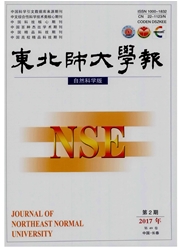

 中文摘要:
中文摘要:
研究了倒极电渗析技术(EDIR)和电去离子技术(EDI)过程中淡出水和浓水室的电导率、p H值、铜离子浓度和膜堆电流,以及运行后离子交换膜和树脂的表面形态。结果表明:EDIR运行15 h的淡出水的电导率为30μS/cm,16 h的铜离子去除率为97.2%。EDI过程中15 h淡出水的电导率550μS/cm,16 h的铜离子去除率为77.8%。EDIR使淡出水的电导率降低,铜离子去除率升高。EDIR淡出水的p H值长期维持碱性,EDI淡出水则由碱性变成酸性、再变成碱性。然而,EDIR和EDI过程中浓水室的电导率和p H值基本接近。EDIR降低了膜堆电流、消除了浓水室阴离子交换膜表面氢氧化铜沉淀,抑制了淡水室中混合树脂表面沉淀。本质上,EDIR通过周期性改变淡水室和浓水室的相对数量和离子迁移方向而消除了膜表面氢氧根离子富集,并缓和了树脂表面水解现象,从而改善了EDIR过程的稳定性。
 英文摘要:
英文摘要:
Electrodeionization reversal( EDIR) technique was used to concentrate and purify copper( Ⅱ) ions- containing wastewater by periodically switching electrode polarity and the inlets of dilute and concentrate compartments in comparison with electrodeionization( EDI). The conductivity,p H value,and concentration of copper( Ⅱ) ions of the exit dilute and concentrate streams,stack current and the morphologies of the ion exchange membranes and resins after service were investigated. The results showed that the EDIR effectively reduced the conductivity of the exit dilute stream from 550 μS/cm down to 30 μS/cm and promoted the removal rate of the copper( Ⅱ)ion of the exit dilute stream from 77. 8% up to 97. 2%. EDIR process made p H value of the exit dilute stream remained alkaline while EDI caused that changed periodically from alkaline to acidic and then to alkaline again.However,no much difference was found in the conductivity and p H value of the exit concentrate streams of EDIR and EDI processes. EDIR process obviously decreased membrane stack current,eliminated formation of Cu( OH)2precipitants on anion exchange membrane surfaces in the concentrate and suppressed its appearing on the mixed resin surfaces in the dilute compartments. Essentially,EDIR process repeatedly varied the relative quantity of the dilute and concentrate compartments as well as the ion migration direction so that it eradicated the enrichment of hydroxyl ions on anion exchange membrane surfaces and abated hydrolysis on the mixed resin surfaces,and thus improved the stability of the membrane stack in the EDIR process.
 同期刊论文项目
同期刊论文项目
 同项目期刊论文
同项目期刊论文
 期刊信息
期刊信息
